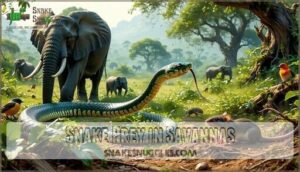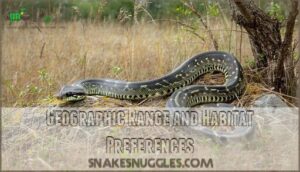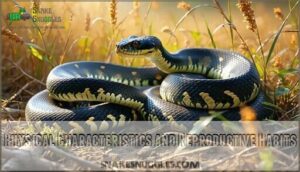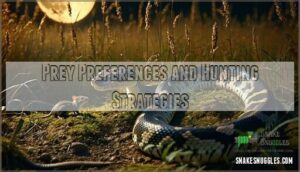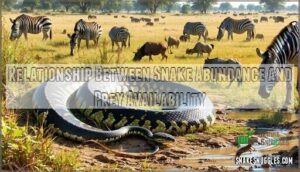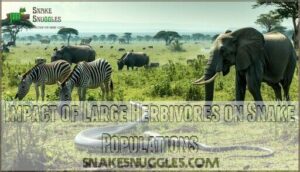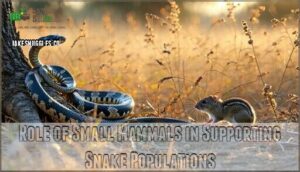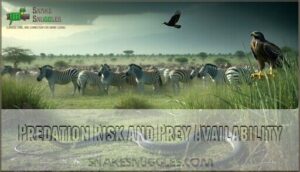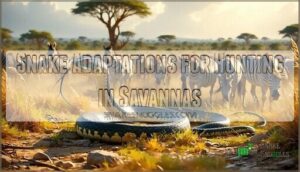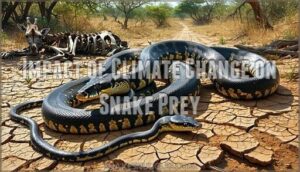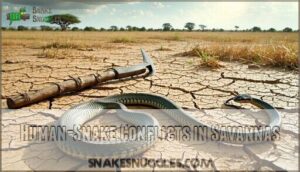This site is supported by our readers. We may earn a commission, at no cost to you, if you purchase through links.
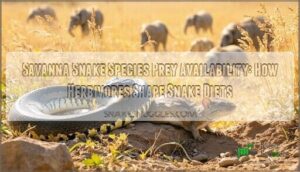
When large herbivores like elephants and zebras disappear from savanna ecosystems, you’d expect snake populations to struggle, but the opposite happens.
These big grazers actually compete with small mammals for resources, so their removal creates a bonanza of rodents, shrews, and other bite-sized prey that snakes absolutely love.
It’s like removing the neighborhood bullies from the cafeteria – suddenly there’s more food for everyone else.
African rock pythons and other savanna snakes capitalize on this abundance, with some populations showing remarkable increases when herbivore density drops.
The ripple effects reveal how interconnected these ecosystems really are, and how the removal of large herbivores can have a significant impact on the ecosystem, creating a new balance that favors small mammals and savanna snakes.
Table Of Contents
- Key Takeaways
- Snake Prey in Savannas
- African Rock Python Habitat and Diet
- Savanna Snake Species and Prey Availability
- Predation Risk and Prey Availability
- Snake Adaptations for Hunting in Savannas
- Impact of Climate Change on Snake Prey
- Human-Snake Conflicts in Savannas
- Conservation of Savanna Snake Species
- Frequently Asked Questions (FAQs)
- What snakes live in the African savanna?
- What do savanna vine snakes eat?
- Do lizards eat savanna vine snakes?
- Are savanna vine snakes venomous?
- What is a savanna vine snake?
- What animals live in the African savanna?
- What do snakes in the savanna eat?
- What snake waits for its prey?
- What animals eat pythons in the savanna?
- Where do most snake species live?
- Conclusion
Key Takeaways
- You’ll see snake populations boom when large herbivores disappear—elephants and zebras compete with small mammals for resources, so their removal creates a rodent bonanza that increases snake numbers by up to 40%.
- You can’t predict snake diets without understanding the herbivore connection—when big grazers vanish, it triggers trophic cascades that flip the entire prey menu upside down, giving snakes access to five times more small mammals.
- You’ll find that climate change and habitat loss are reshaping snake-prey relationships—shifting rainfall patterns and temperature changes force both snakes and their prey to relocate, creating new predator-prey dynamics in unexpected areas.
- You need to consider the conservation puzzle—protecting savanna snakes means understanding that removing large herbivores doesn’t hurt snake populations as you’d expect, but actually helps them thrive through increased prey availability.
Snake Prey in Savannas
When you look at snakes in the savanna, you’ll notice their menu depends a lot on what’s scurrying around—mostly small mammals, but also frogs, birds, and even the odd invertebrate.
If you’ve ever wondered why some snakes are picky eaters while others aren’t, it’s all about which prey species are plentiful and how big herbivores, like elephants, shake up the buffet.
Small Mammals as Primary Prey
Imagine the savanna as a buffet, and small mammals are the go-to snack for hungry snakes. Their high numbers and variety help meet snake dietary needs, while easy-to-reach burrows boost prey availability.
Here’s why they matter:
- High rodent population dynamics
- Diverse prey choices
- Habitat accessibility
- Conservation implications for savanna snakes
Impact of Large Herbivores on Prey Availability
When small mammals are munching away, large herbivores step in and shake up the buffet.
Large herbivores crash the party and flip the entire prey menu upside down.
Their appetite trims down snake prey, sparking real competition for resources. If you boot out these big grazers, you’ll see a fivefold jump in small mammal numbers—talk about Herbivore removal benefits!
That’s a classic case of Trophic cascade effects in the savanna ecosystem.
Access to medicinal plant resources is also essential for herbivore health, influencing the entire food web.
Role of Keystone Species in Shaping Prey Populations
Whether elephants are toppling trees or grazing endlessly, their herbivore impact ripples through the system. As keystone species, they’re like ecosystem managers, tweaking competition, boosting snake prey, and keeping prey availability in check.
It’s all about prey regulation and balance—when these giants thrive, so do savanna snakes. That’s Keystone effects at work, plain and simple.
Ecosystem engineers like elephants alter habitats substantially.
- Shape habitats for prey species
- Control small mammal populations
- Influence grassland structure
- Regulate snake prey abundance
- Maintain ecosystem management and stability
Trophic Cascade Effects on Snake Prey
When herbivores clock out, you’ll see a rodent increase and catch the whole food web buzzing.
Suddenly, snake abundance rises—more snake prey means more meals for every hungry savanna snake species.
It’s a textbook trophic cascade; herbivore removal sets off ecosystem impacts, reshuffling food chain dynamics and cranking up prey availability for snakes in ways you wouldn’t expect.
African Rock Python Habitat and Diet
You’ll find the African rock python soaking up sun in savannas, rocky outcrops, and sometimes dropping into burrows for a quick snack or shelter—that’s one flexible reptile.
These giants tackle everything from rodents to antelope, so if you’re picturing a snake with an “all you can eat” diet plan, you’re spot on, and it’s clear they have a very flexible approach to their meals.
Geographic Range and Habitat Preferences
Snake prey in the African savanna is all about location, location, location—just ask the African Rock Python.
This heavyweight prefers real estate where Range Overlap means a buffet of options.
You’ll spot them where Habitat Specificity wins the day:
- savanna grasslands with plenty of snake prey species
- moist forests promising shade and food
- rocky hideouts for Microhabitat Selection
- burrows thanks to Habitat Fragmentation
Pythons globally inhabit diverse environments across the world.
Physical Characteristics and Reproductive Habits
Picture the African savanna: blazing sun, tall grasses, and the African Rock Python showing off its impressive snake morphology.
These muscular giants know a thing or two about survival—laying up to 50 eggs per clutch.
With sharp sensory adaptations, clever reproduction strategies, and steady thermoregulation behavior, they’re masters of the hunt.
Even snakes need a family plan—just ask one about their busy schedule.
| Trait | Detail | Why It Matters |
|---|---|---|
| Morphology | Large, robust build | Nabs bigger prey |
| Reproduction | Sexual dimorphism | Agility and hunting prowess |
| Clutch Size | 20-50 eggs | Grows population quickly |
| Sensory Gear | Heat, scent, sight | Tracks prey with precision |
Conservation Status and Threats
Now that you know how the rock python lives, let’s get real about why it’s in trouble.
Habitat loss, climate impacts, and human persecution leave deep marks.
Here’s what’s shrinking their numbers:
- Bulldozed grasslands
- Lost prey—hello, prey depletion!
- Illegal capture for sale
- Roadkill disasters
Snake conservation needs stronger conservation strategies and teamwork.
Prey Preferences and Hunting Strategies
A master of Ambush Tactics, the African rock python waits for the right moment, blending into tall grass for a classic nocturnal hunting scene.
With Venom Optimization off the table, it relies on Scent Tracking and Heat Sensing to nab small mammals—those night-shift snacks boost the snake diet.
Prey availability makes all the difference for savvy savanna snakes.
| Hunting Mode | Key Adaptation | Example Prey |
|---|---|---|
| Ambush Tactics | Heat Sensing | Rodents |
| Nocturnal Hunting | Scent Tracking | Birds, mammals |
| Stealth Approach | Camouflage | Reptiles, birds |
| Opportunistic | Prey Availability | Varied snake prey |
Savanna Snake Species and Prey Availability
You’ll notice that every savanna snake species picks its menu based on what’s actually crawling, hopping, or slithering nearby.
Their numbers go up or down depending on how much dinner is available, it’s like a high-stakes buffet—if large herbivores chase away small mammals, suddenly, even the hungriest python starts wishing for seconds.
Relationship Between Snake Abundance and Prey Availability
Ever notice how some savanna snake species seem to thrive when prey density is high?
You’re not imagining things—prey availability directly shapes snake abundance.
Trophic dynamics are always shifting; climate effects or sudden habitat changes can turn the buffet into a famine.
Depending on herbivore impact and those twists in nature, your typical snake prey preferences might get a total makeover.
Impact of Large Herbivores on Snake Populations
In the context of herbivore-snake interactions, large herbivores are like the ecosystem’s bulldozers—shaping habitats and shaking up food webs.
Here’s how they impact savanna snakes:
- Reduce snake prey and prey availability
- Trigger trophic cascade effects
- Spark habitat modification
- Fuel prey competition
- Alter overall snake populations
Balance matters!
Role of Small Mammals in Supporting Snake Populations
Take a stroll through the savanna, and you’ll spot small mammals hustling about—these busybodies are the MVPs of snake ecology.
Savanna snakes depend on prey availability, and thanks to dynamic mammal populations, snakes get plenty of dietary diversity.
When rodent numbers spike, snakes thrive, it’s classic trophic support in action: easy access means full bellies and healthier populations, showcasing the importance of prey availability.
Comparison of Snake Species and Their Prey Preferences
You’ll notice savanna snake species don’t just eat what’s handy—their dietary specializations come from venom variation, hunting strategies, and even prey size.
Some prefer rodents, others go straight for insects or frogs, and their tastes change as they grow (ontogenetic shifts).
In the context of snake feeding habits, it’s basically nature’s own buffet line.
- Tiny pythons scarf rodents
- Garter snakes love amphibians
- Rock pythons swallow massive prey
Predation Risk and Prey Availability
You’re about to see how a hungry snake has to read the savanna like a buffet menu—availability of prey and the risk of becoming prey themselves make every meal a calculated decision.
If you’ve ever tried grabbing a snack and dodging your older sibling at the same time, you’ll get why fluctuations in prey numbers and lurking predators shape snake diets in surprising ways.
Factors Influencing Predation Risk in Savannas
If you’ve wandered the African savanna, you know snake hunting isn’t just about pouncing—predator density, habitat structure, and seasonal effects all play big roles.
Low prey availability or high predator numbers can send predation risk soaring.
Scientists even use lizard models to test these dynamics.
| Factor | Effect on Snakes | Fun Fact |
|---|---|---|
| Predator density | Increases risk | More competition, less food |
| Habitat structure | Hiding spots matter | Snakes love cover! |
| Seasonal effects | Shifts behavior | Rainy = more action |
| Prey availability | Dictates hunting | Feast or famine |
| Lizard models | Simulate real risks | Plastic lizards get bitten! |
Role of Alternative Prey Sources in Shaping Predation Risk
Ever wonder how invertebrate predation shakes up snake hunting in the savanna? Just imagine this:
- When prey availability shifts, alternative prey like juicy bugs spread out the risk.
- Avian predators swoop in, targeting what’s most abundant.
- Lizard models show how seasonal variation and habitat influence drive predatorprey relationships.
More prey choices mean snakes feel less heat from hungry beaks, due to alternative prey!
Impact of Predator Density on Prey Populations
Here’s a twist: in the context of predator-prey dynamics in savannas, it isn’t always about how many predators are on the scene.
Sometimes, prey availability takes center stage, with predator density playing a smaller role.
This type of density-dependent predation can help balance prey population control, keeping ecosystem stability in check, especially for hungry savanna snakes.
Multi-Level Investigation of Predation Risk
Step into savanna snake ecology, and you’ll see predation risk isn’t just about predator density. Turns out, when alternative prey are everywhere, snakes get pickier, making life tougher for artificial lizards in the mix.
You’ll notice:
- Seasonal predation impacts prey abundance
- Habitat influence shapes predation risk
- Changes in prey availability trigger shifts in snake behavior
- Complex food webs challenge simple assumptions
Snake Adaptations for Hunting in Savannas
You’ll notice savanna snakes have turned hunting into an art form, blending into tall grass with perfect camouflage while tracking rodents, frogs, and even the occasional unlucky bird.
Scientists have measured adaptations like heat-sensing pits, stealthy movement, and even venom potency—all helping these reptiles snag a quick meal before predators or bad weather spoil the hunt.
Physical Adaptations for Hunting and Survival
Now, picture savanna snakes as real-life magicians—each trick customized for dinner.
Their muscular build powers quick strikes. Venom delivery turns a single bite into a game-changer.
A snake’s camouflage effectiveness—think earth-toned scales—lets them vanish in plain sight. To further enhance their concealment, some species exhibit cryptic snake coloration.
Sensory adaptations, from scent tracking to heat-sensing pits, help zero in on prey. Scalation benefits boost movement across tricky terrain.
Behavioral Adaptations for Hunting and Avoiding Predators
You’ll find three savvy strategies at play when savanna snakes hunt: Ambush Tactics, Nocturnal Hunting, and Heat Sensing.
These cold-blooded hunters blend in, wait patiently, and pounce with military precision.
They sniff out prey with Scent Tracking, but don’t forget—they’re dodging predators too!
To safely manage these reptiles, professionals often use specialized gripping tools.
| Ambush Tactics | Nocturnal Hunting | Scent Tracking |
|---|---|---|
| Surprise prey | Hunt at night | Detect subtle scents |
Importance of Camouflage and Stealth in Hunting
Mastering camouflage and stealth mechanisms gives savanna snakes their evolutionary advantage in hunting success and predator avoidance.
You’ll find these snake stealthy ambush tactics incredibly effective when prey availability fluctuates.
- Pattern matching: Scales mimic grass textures and soil colors perfectly
- Freeze-frame positioning: Motionless waiting conserves energy while maximizing camouflage effectiveness
- Shadow exploitation: Strategic positioning uses natural lighting for concealment
- Gradual approach: Ultra-slow movement prevents detection during hunting strategies
Role of Scent and Tracking in Hunting
How do savanna snakes become such skilled hunters? They’re basically living chemical detectors with tongues that work overtime.
When you watch a snake hunt, you’ll notice its tongue-flicking rate increases dramatically near prey—that forked tongue collects chemical cues and delivers them to the Jacobson’s organ for analysis.
This scent gland evolution gives snakes incredible tracking success factors in complex savanna terrain. Savanna snakes use advanced scent detection for hunting.
| Sensory Feature | Hunting Function | Prey Detection Range |
|---|---|---|
| Forked tongue | Collects chemical particles | Several meters |
| Jacobson’s organ | Analyzes prey chemical cues | Highly specific |
| Heat-sensing pits | Detects warm-blooded prey | Close proximity |
Impact of Climate Change on Snake Prey
You’ve probably noticed that climate change isn’t just making your summers sweatier—it’s shaking up prey populations for snakes, too, leading to some unusual eating habits.
As weather patterns shift and rainfall gets unpredictable, snakes might start craving a wider menu, so don’t be surprised if a python snacks on something you’d never expect, like a python.
Changes in Prey Populations Due to Climate Change
Climate change is dramatically reshaping prey availability for savanna snake species, creating a perfect storm of challenges.
When rainfall pattern changes disrupt the delicate balance, you’ll notice cascading effects throughout the ecosystem:
- Prey distribution shifts as small mammals abandon traditional territories for scarce resources
- Habitat degradation reduces shelter options, making remaining prey more vulnerable to predation
- Temperature impacts alter insect abundance cycles, disrupting snake food sources
This climate-driven extinction risks scenario forces snakes to adapt or perish.
Shifts in Snake Distribution and Abundance
When habitat fragmentation disrupts traditional territories, you’ll notice snake ecology shifting dramatically.
Climate effects force savanna snake species to relocate, creating prey scarcity in some areas while concentrating populations elsewhere.
Human encroachment compounds these challenges, making conservation strategies essential for maintaining snake distribution patterns.
| Climate Impact | Snake Response |
|---|---|
| Rising temperatures | Northward migration patterns |
| Altered rainfall | Changed activity periods |
| Habitat loss | Compressed range boundaries |
| Prey shifts | Modified hunting territories |
| Extreme weather | Population bottlenecks |
Impact of Climate Change on Snake-Human Conflicts
Rising temperatures push snakes into human settlements as habitat loss and prey scarcity force desperate searches for food and shelter.
You’ll notice increased encounters during extreme weather events when traditional territories become uninhabitable, creating dangerous situations that require immediate mitigation strategies.
Key climate-driven conflict factors:
- Increased encounters occur when droughts force snakes toward water sources near homes
- Habitat loss from changing precipitation patterns pushes species into agricultural areas
- Prey scarcity drives hungry snakes to raid chicken coops and livestock areas
- Human encroachment into marginal habitats creates overlap zones during climate stress
- Mitigation strategies must adapt to unpredictable snake behavior patterns under climate pressure
Conservation Efforts for Snake Species in Savannas
With species protection hanging in the balance, you’ll find that snake conservation efforts focus on three key strategies: habitat preservation, research funding, and community education.
These savanna snake species face mounting pressure from climate change and human encroachment, making wildlife preservation critical for maintaining ecological balance and prey availability.
| Conservation Strategy | Implementation Methods | Expected Outcomes |
|---|---|---|
| Habitat Protection | Protected area establishment, corridor creation | Maintained snake habitat, stable prey populations |
| Research Programs | Population monitoring, ecological studies | Better understanding of snake ecology, informed policies |
| Community Outreach | Education campaigns, farmer training | Reduced human-snake conflicts, increased support |
| Anti-poaching Efforts | Enforcement patrols, legal frameworks | Protected snake populations from illegal trade |
| Restoration Projects | Degraded habitat rehabilitation, native vegetation | Enhanced ecosystem function, improved conservation status |
The conservation strategies are designed to address the pressing issues affecting snake populations, including human-snake conflicts and illegal trade, by implementing measures such as protected area establishment and education campaigns.
Human-Snake Conflicts in Savannas
You might think running into a snake while you’re just trying to farm or take a walk is pure bad luck, but data shows these encounters spike when snakes and people share shrinking habitats or chase the same small mammals.
Researchers have found that risky farming habits, rainy-season snake activity, and a shortage of health services all turn a simple stroll into a surprise game of “avoid the viper,” especially in savannas where both species are just trying to survive, due to shrinking habitats.
Causes of Human-Snake Conflicts in Savannas
Surprisingly often, human-snake conflicts in savannas stem from habitat fragmentation and agricultural expansion.
You’re basically moving into their neighborhood! Farming activities increase encounters, especially during rainy seasons when snake behavior shifts.
Human activities like livestock grazing reduce prey availability, forcing snakes closer to settlements.
Poor lighting, inadequate footwear, and limited knowledge about savanna snake species ecology worsen conflicts, disrupting ecological balance and requiring targeted conflict resolution strategies.
Impact of Human Activities on Snake Populations
You’re witnessing a perfect storm where human activities create chaos for snake populations.
When we expand farmlands and build roads, we’re basically rewriting the rules of survival for these reptiles.
- Habitat Destruction fragments snake territories, forcing them into smaller, less suitable areas
- Human Encroachment reduces prey abundance as small mammals lose their homes too
- Snake Trade removes breeding adults from wild populations, disrupting natural cycles
- Pollution Effects contaminate food webs, weakening both snakes and their prey
- Climate Shift from land-use changes alters predator-prey interactions across savannas
Strategies for Mitigating Human-Snake Conflicts
With proper conflict prevention, you’ll reduce snake-human conflicts through community education and safe practices.
Train locals in snake identification, establish rapid rescue teams, and implement relocation strategies for captured snakes.
To further support local snake populations, consider creating a snake habitat in designated areas.
Make certain antivenom access at health centers while modifying habitats around homes.
Snake livestock protection and awareness campaigns create lasting coexistence between communities and wildlife.
Importance of Education and Awareness in Conflict Resolution
Community education breaks down barriers between humans and snakes.
When you understand snake behavior, safe practices, and first aid basics, snakehuman conflicts drop dramatically.
Teaching locals about antivenom access and conflict prevention creates safer communities.
Snake awareness programs work best when they respect cultural beliefs while promoting evidence-based mitigation strategies.
Smart snake education saves lives, and by understanding snake behavior, communities can implement effective conflict prevention measures.
Conservation of Savanna Snake Species
You can help protect savanna snakes by understanding how everything from habitat loss to climate shifts messes with their food and shelter, sometimes leaving them hungry or homeless.
It’s not just about saving snakes—you’re really pitching in to keep the whole food web stable (plus, no one wants a rodent takeover, right?), which is crucial for maintaining a healthy ecosystem and preventing issues like a rodent takeover.
Threats to Snake Populations in Savannas
Multiple snake threats are decimating savanna populations.
Habitat loss from agriculture destroys den sites, while climate change shifts prey distributions.
Human persecution kills snakes out of fear, and prey depletion from overgrazing starves populations.
Invasive species compete for resources, creating a perfect storm that’s turning snake survival into an uphill battle requiring urgent conservation efforts.
Importance of Habitat Preservation and Restoration
You can’t save savanna snakes without protecting their homes first.
Habitat preservation creates wildlife corridors that connect fragmented landscapes, boosting biodiversity hotspots where reptile diet diversity thrives.
Restoration techniques involving community involvement rebuild damaged ecosystems, ensuring prey abundance and habitat connectivity support snake survival strategies while maintaining essential ecosystem services for savanna wildlife.
These efforts may require specialized habitat products.
Role of Research and Monitoring in Conservation Efforts
Consistently conducting snake research and prey abundance studies creates the foundation for effective savanna wildlife conservation.
Data-driven conservation strategies, powered by citizen science and technology integration, help you track population changes and habitat shifts.
Predictive modeling transforms raw monitoring data into actionable insights, while adaptive management helps your conservation efforts stay flexible and responsive to changing conditions.
Understanding snake microhabitat utilization is vital for effective conservation planning.
Frequently Asked Questions (FAQs)
What snakes live in the African savanna?
You’ll find African rock pythons dominating savanna landscapes, alongside venomous species like carpet vipers, night adders, and black-necked spitting cobras. These adaptable hunters thrive where diverse prey meets suitable shelter.
What do savanna vine snakes eat?
Here’s one wild fact: some savanna snakes get nearly 70% of their nutrition from vertebrates like frogs and rodents.
You’ll find vine snakes primarily hunting small prey including amphibians, invertebrates, and occasionally small mammals, adapting their diet based on what’s available in their habitat, which can include small mammals.
Do lizards eat savanna vine snakes?
Yes, lizards can eat smaller savanna vine snakes, especially juveniles.
However, most adult vine snakes are too large for typical savanna lizards to handle, so it’s more common for vine snakes to prey on lizards instead.
Are savanna vine snakes venomous?
Research shows 6% of artificial lizard attacks come from predatory birds, not venomous bites.
Savanna vine snakes aren’t venomous – they’re constrictors that squeeze prey instead of injecting toxins, making them harmless hunters.
What is a savanna vine snake?
You’ll spot a savanna vine snake as a slender, arboreal species perfectly adapted for life in trees.
They’re graceful climbers with elongated bodies, excellent camouflage, and lightning-fast reflexes for catching prey.
What animals live in the African savanna?
Picture yourself walking through Kenya’s Maasai Mara at dawn—you’ll spot elephants, lions, zebras, giraffes, cheetahs, hippos, and countless antelope species roaming these grasslands, creating Africa’s most spectacular wildlife showcase.
What do snakes in the savanna eat?
Savanna snakes eat diverse prey including small mammals, amphibians, birds, reptiles, insects, and mollusks.
You’ll find African rock pythons tackling everything from rodents to 59-kilogram impalas, while smaller species prefer frogs and invertebrates.
What snake waits for its prey?
Like a coiled spring waiting to strike, ambush predators such as pythons and vipers remain motionless for hours.
You’ll find these patient hunters using stealth tactics, relying on camouflage while they wait for unsuspecting prey.
What animals eat pythons in the savanna?
You’ll find that several predators target pythons in savannas.
Large birds like secretary birds and martial eagles hunt juveniles, while mammals including honey badgers, leopards, and hyenas attack adults when they’re vulnerable during digestion or shedding.
Where do most snake species live?
You’ll discover most snake species thrive in tropical and temperate regions worldwide. They’re incredibly adaptable creatures, inhabiting forests, deserts, grasslands, wetlands, and even urban areas where prey’s abundant.
Conclusion
Remarkably, African rock python populations can increase by up to 40% when large herbivore densities drop, creating a ripple effect that transforms entire ecosystems.
You’ve seen how savanna snake species prey availability hinges on this delicate balance between big grazers and small mammals.
When elephants and zebras disappear, they’re not just removing themselves—they’re releasing a buffet of rodents and shrews that snakes can’t resist.
Understanding these connections helps you appreciate how every species, from the tiniest shrew to the largest python, plays a vital role in maintaining savanna harmony, and how each species is connected in a delicate balance, creating a delicate balance between big grazers and small mammals, ultimately leading to a transformed ecosystem.
- https://animals.howstuffworks.com/snakes/african-rock-python.htm
- https://bioone.org/journals/journal-of-herpetology/volume-43/issue-1/07-298R1.1/Food-Habits-of-the-Plains-Garter-Snake-Thamnophis-radix-at/10.1670/07-298R1.1.short
- https://digitalcommons.usu.edu/cgi/viewcontent.cgi?article=2747&context=biology_facpub
- https://aha.org.ar/wordpress/wp-content/uploads/2023/05/2019_33_02_03.pdf
- https://tpyoung.ucdavis.edu/sites/g/files/dgvnsk4821/files/inline-files/indirect%20effects%20of%20large%20herbivores_1.pdf

